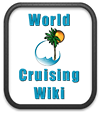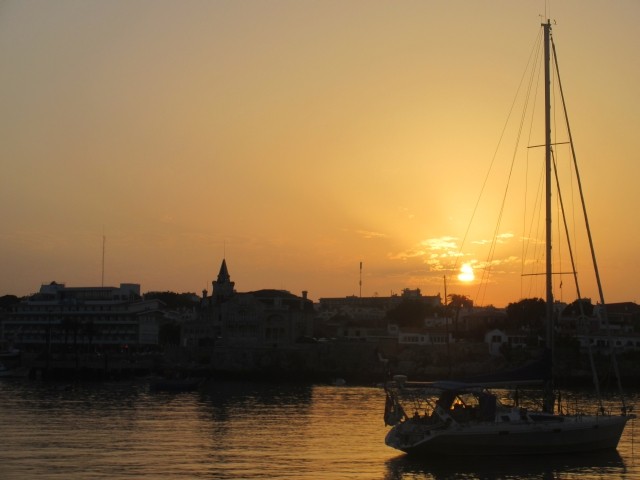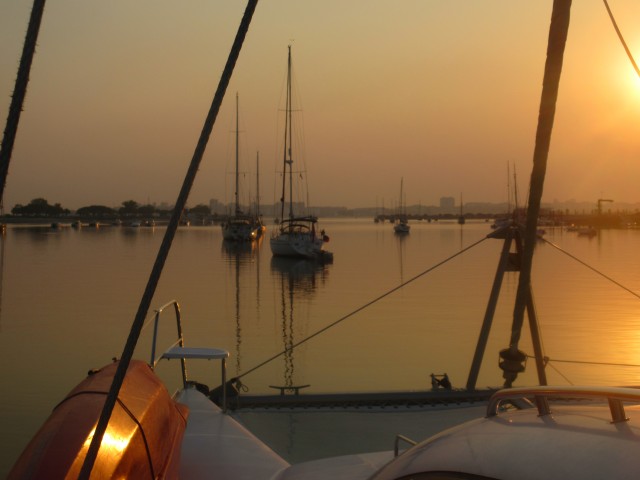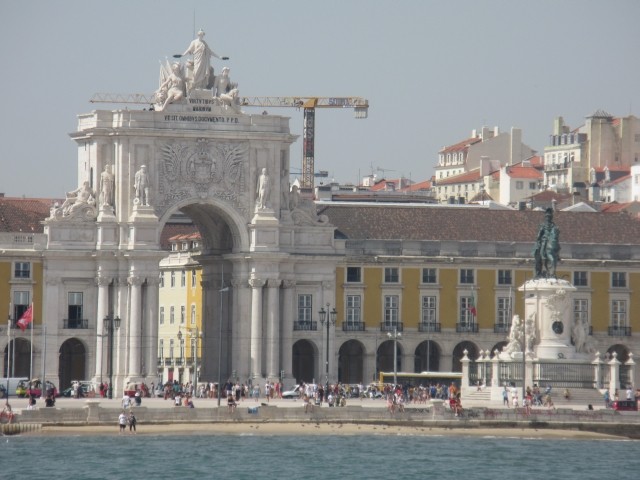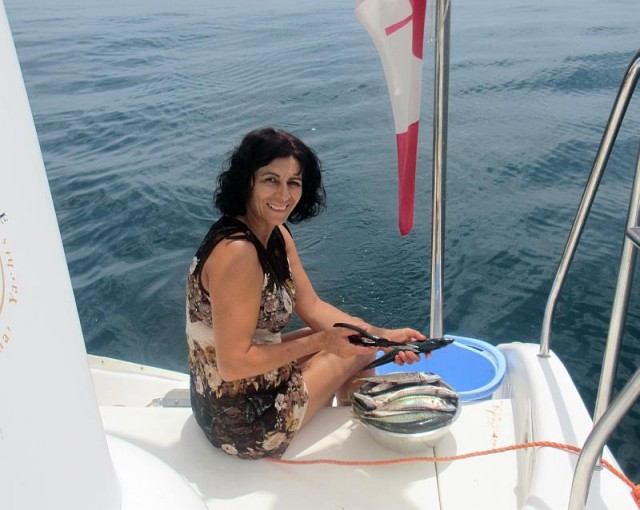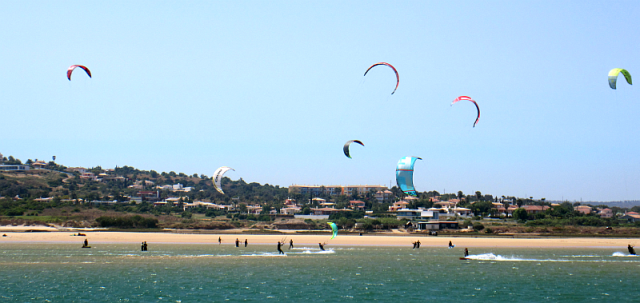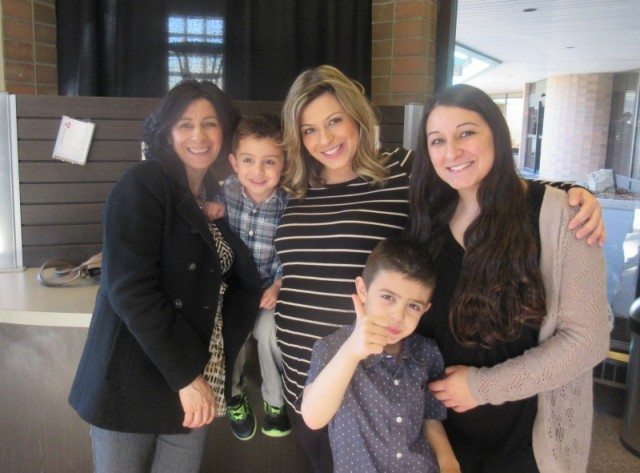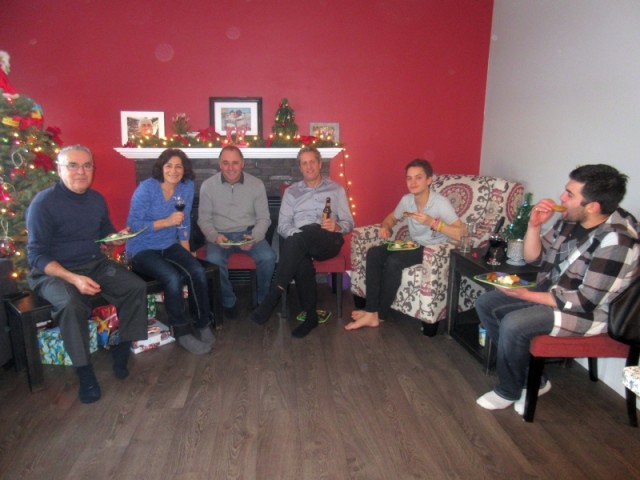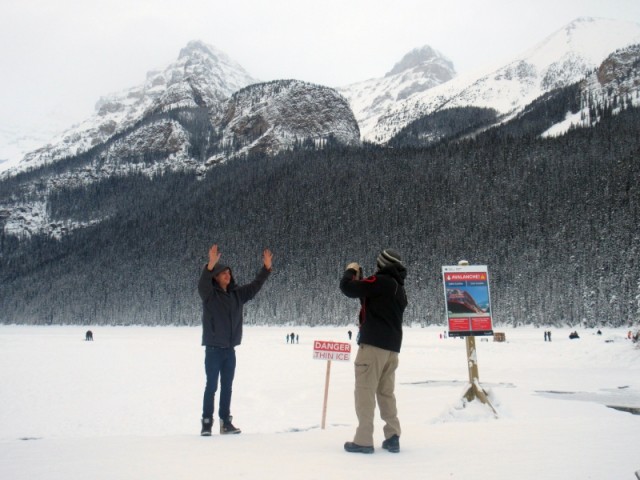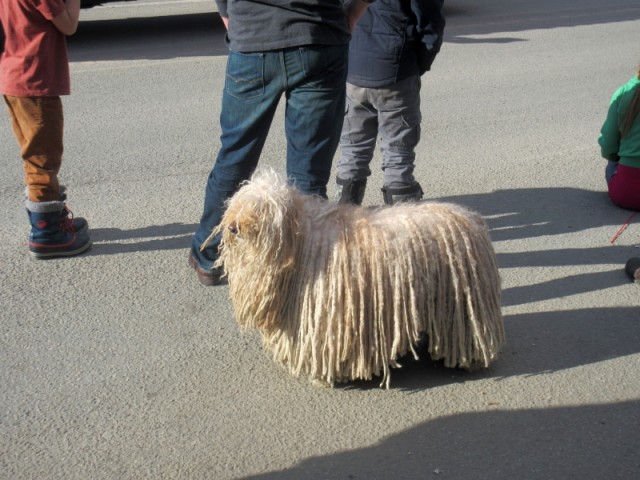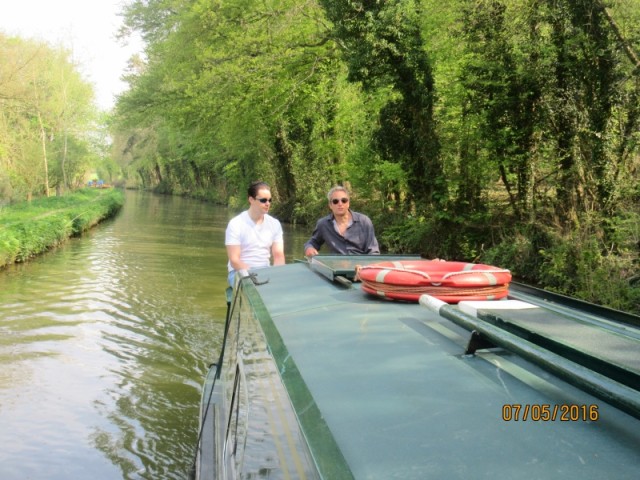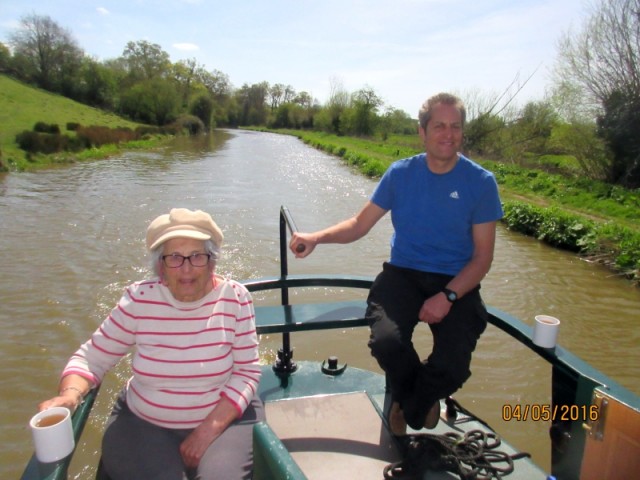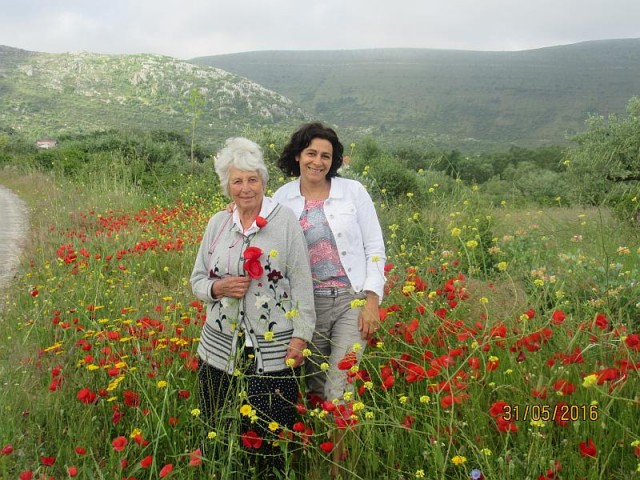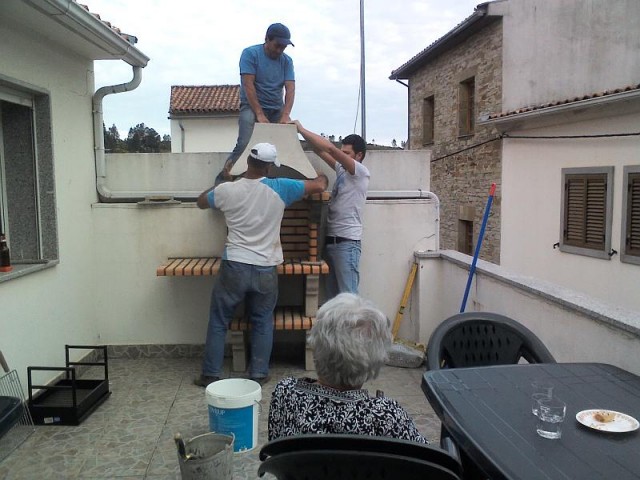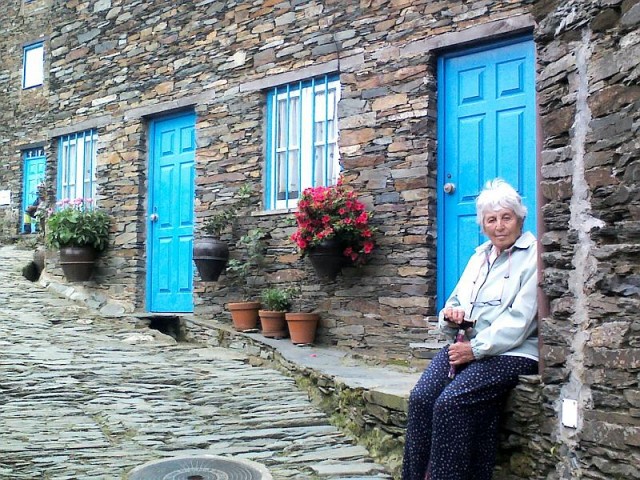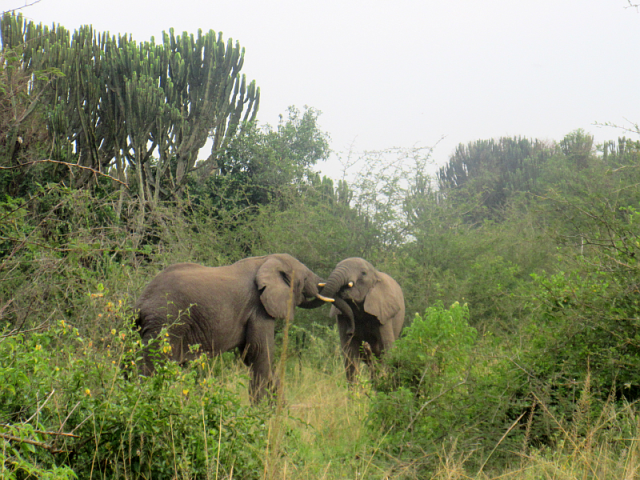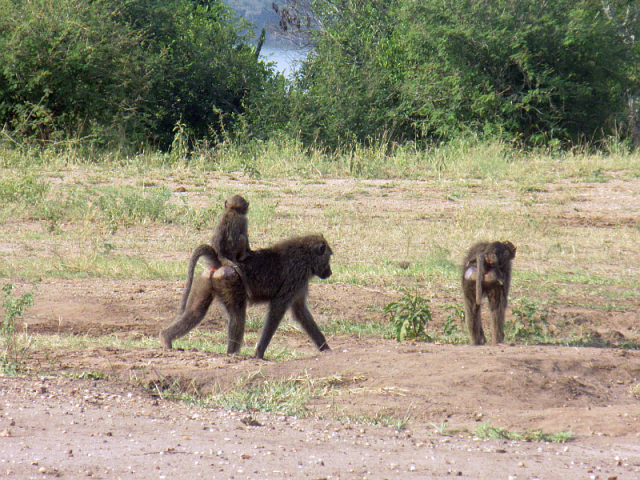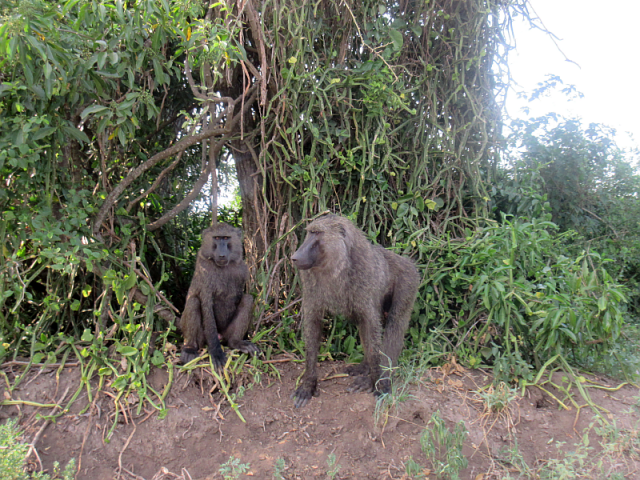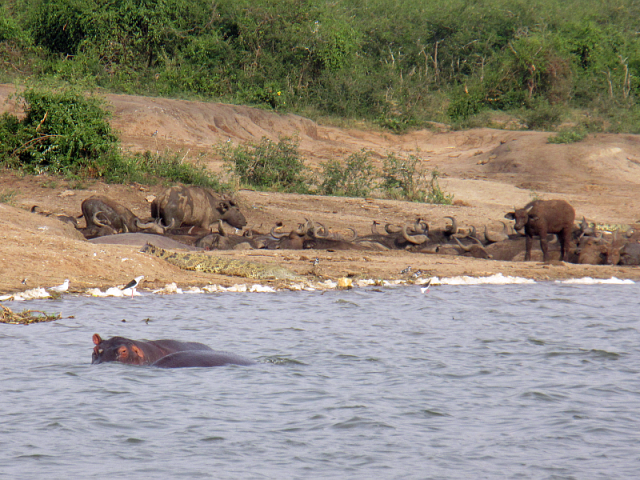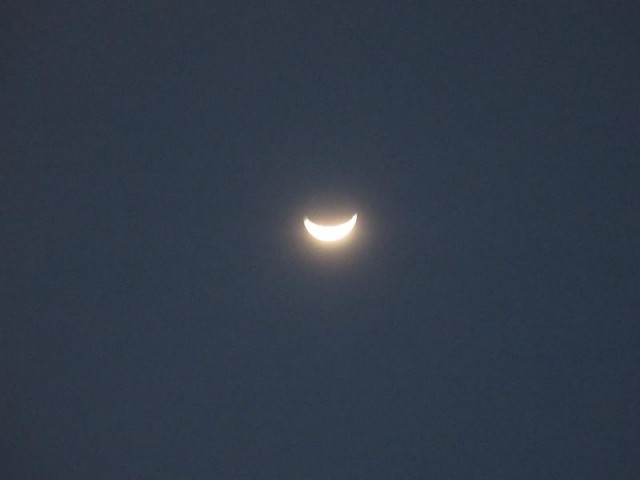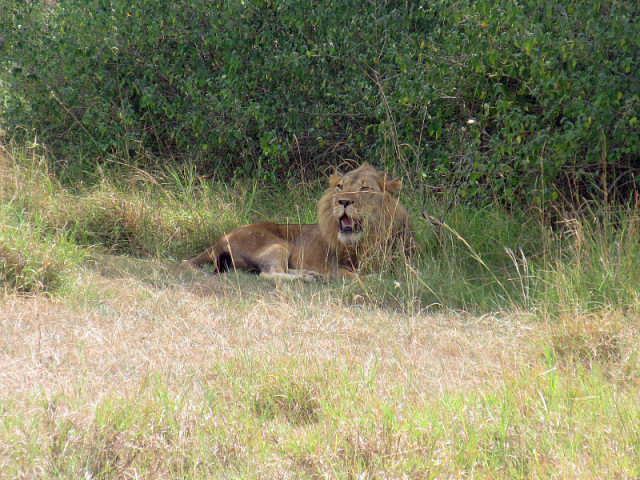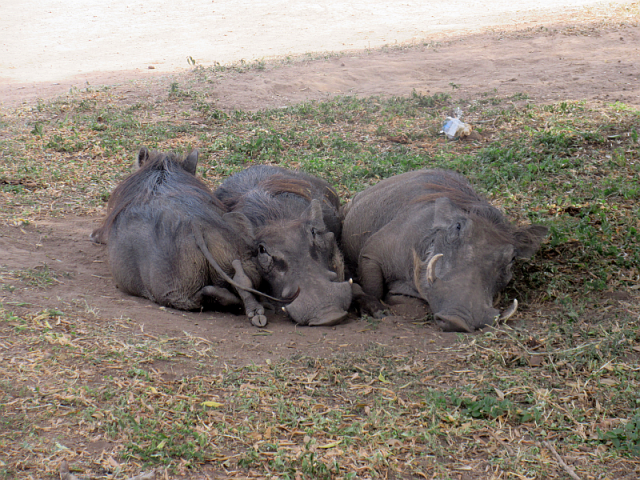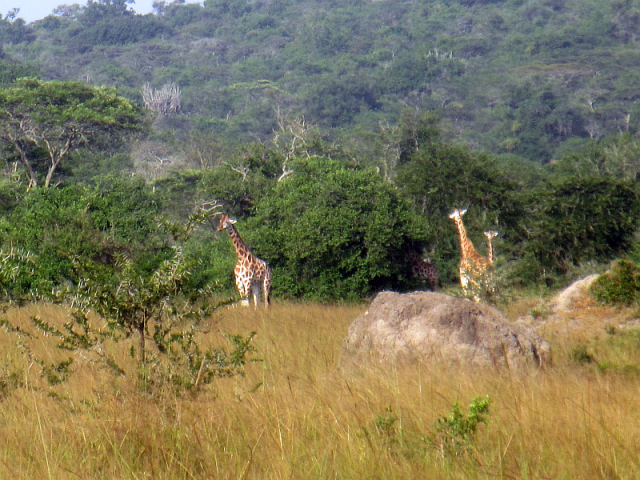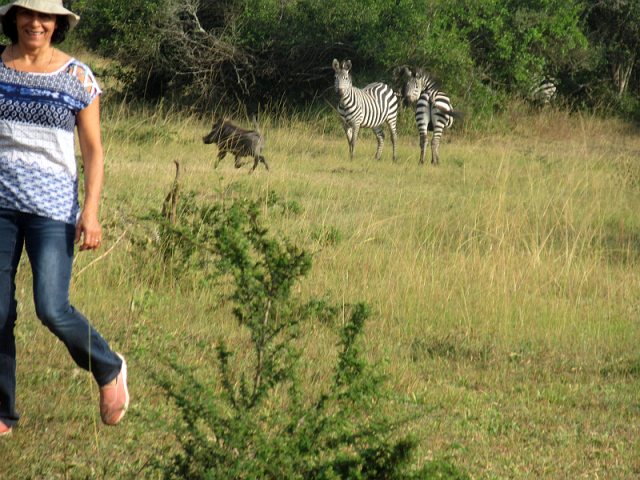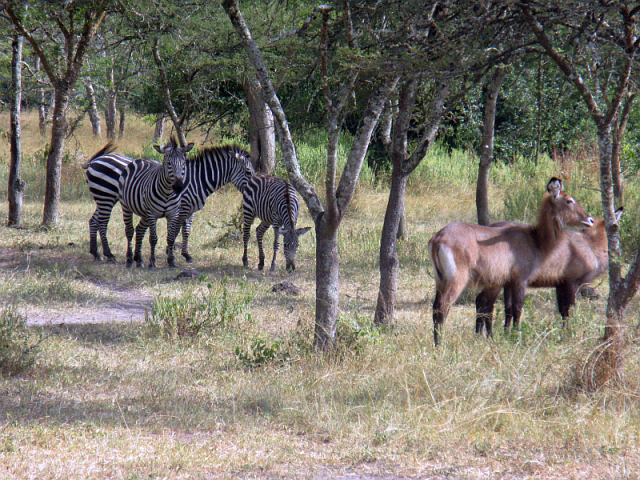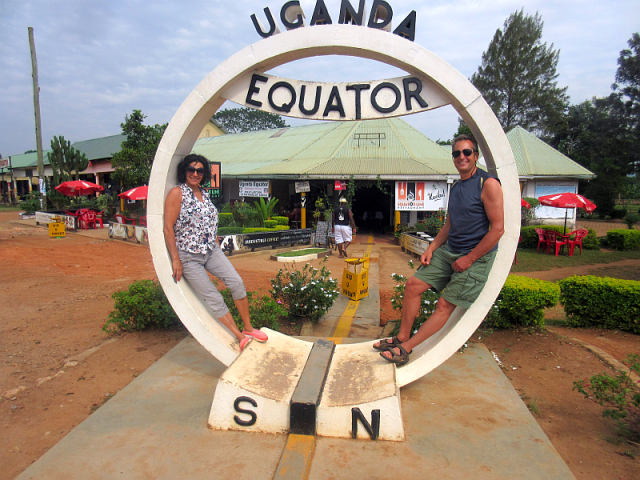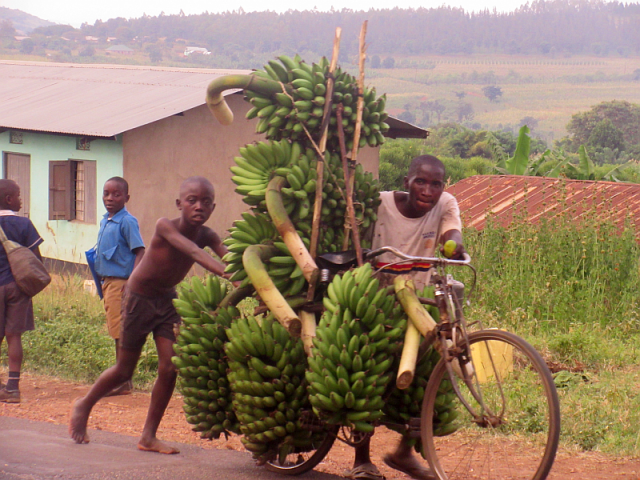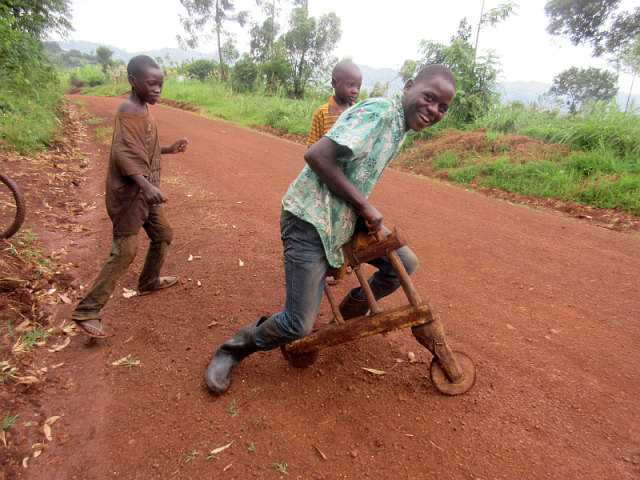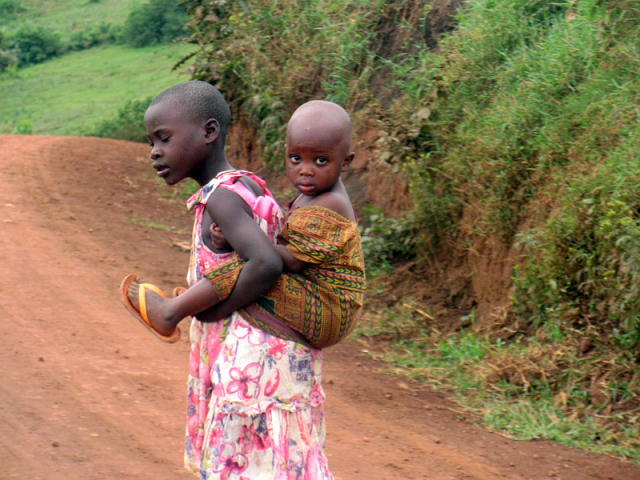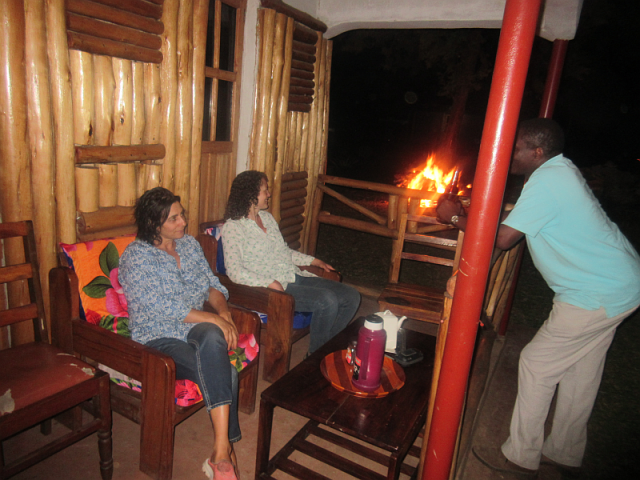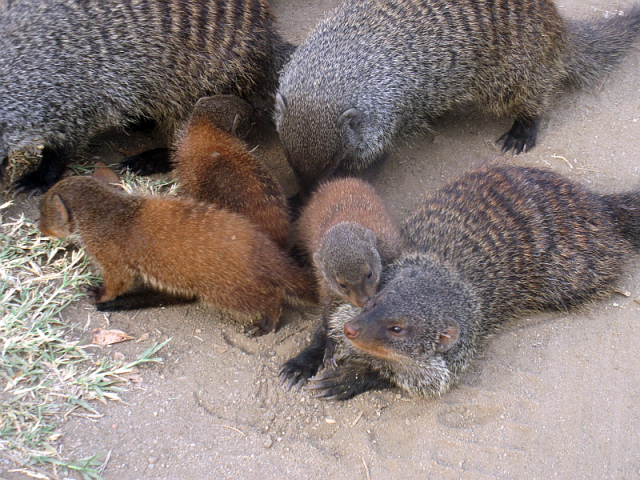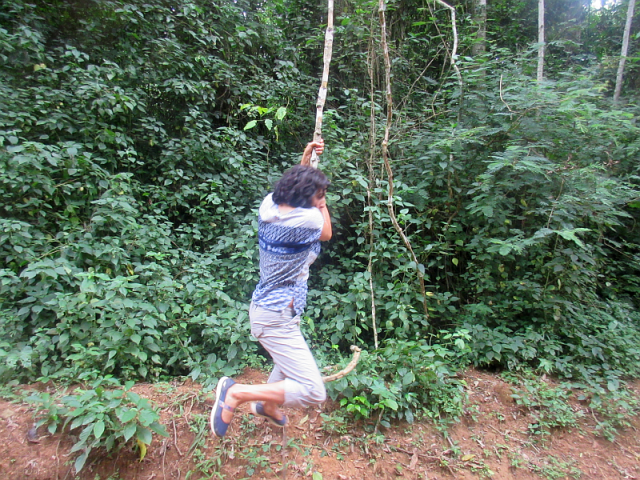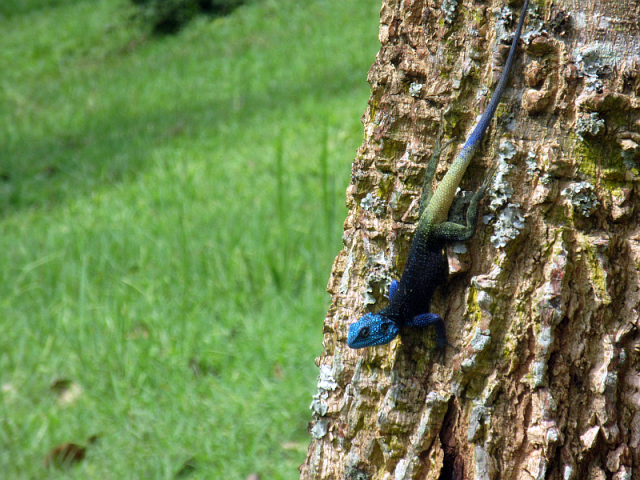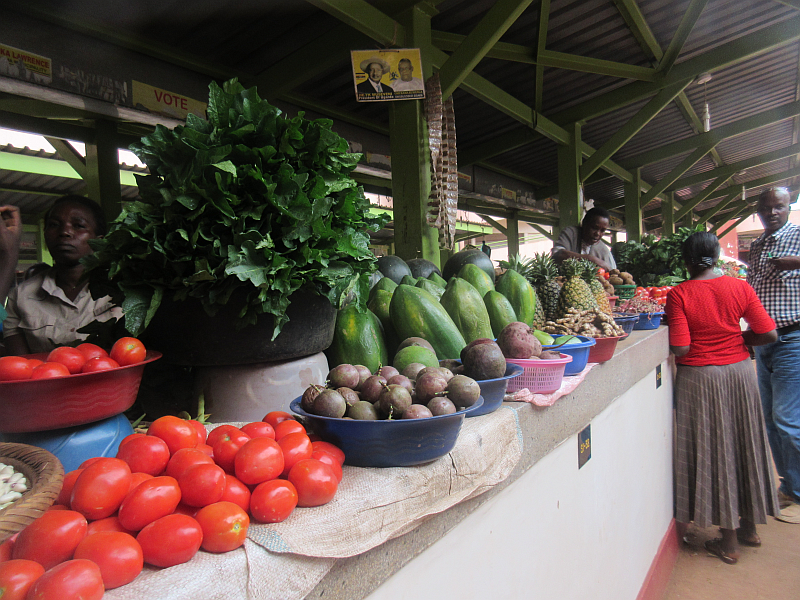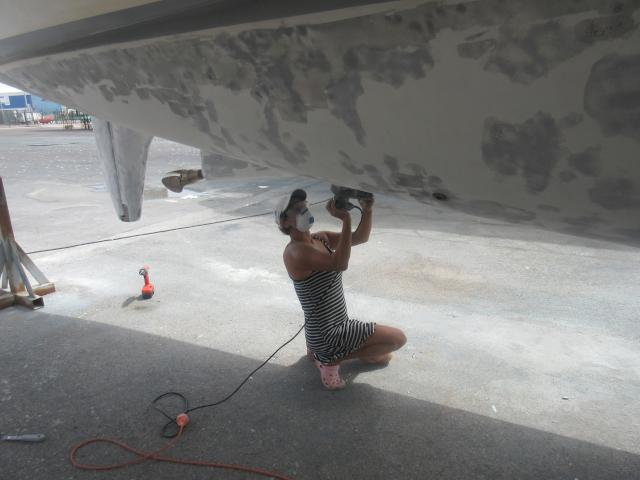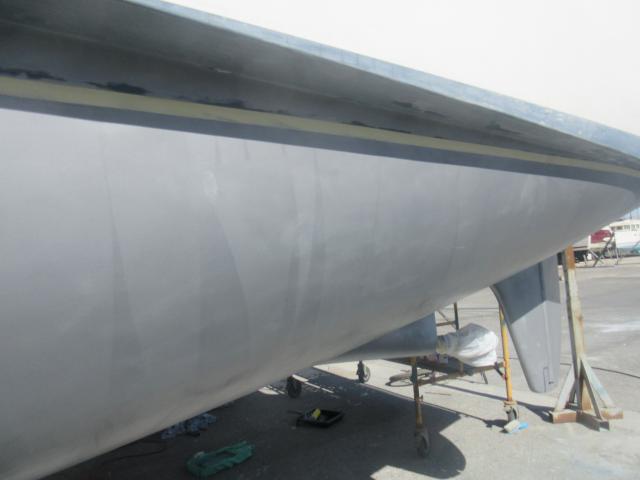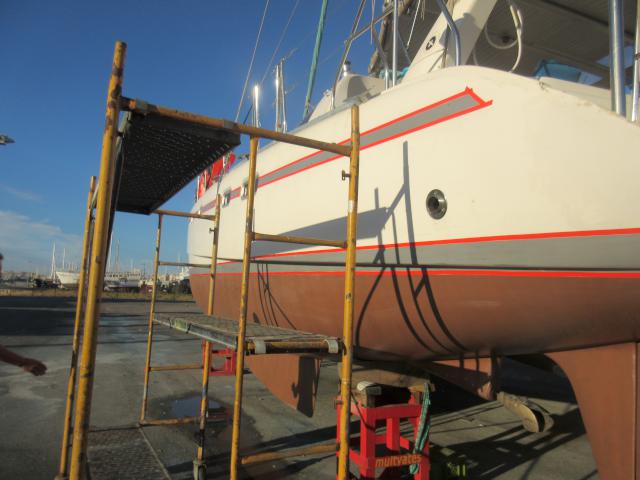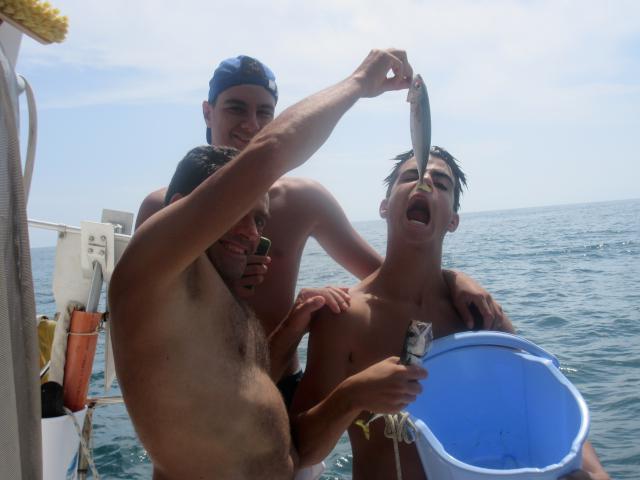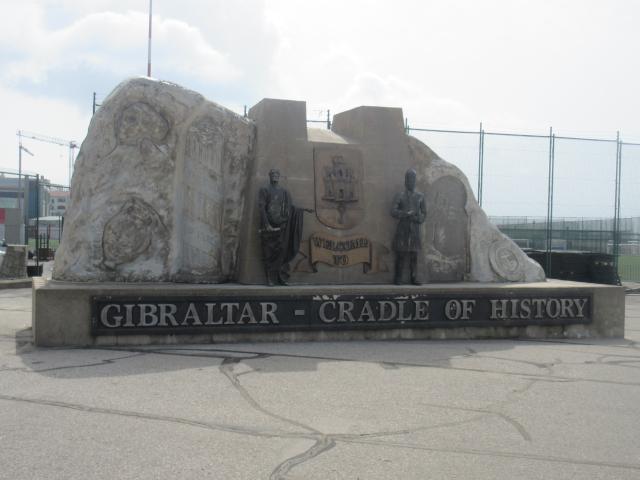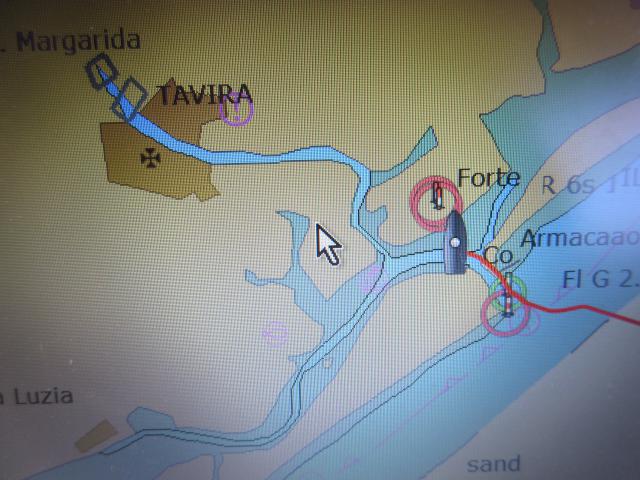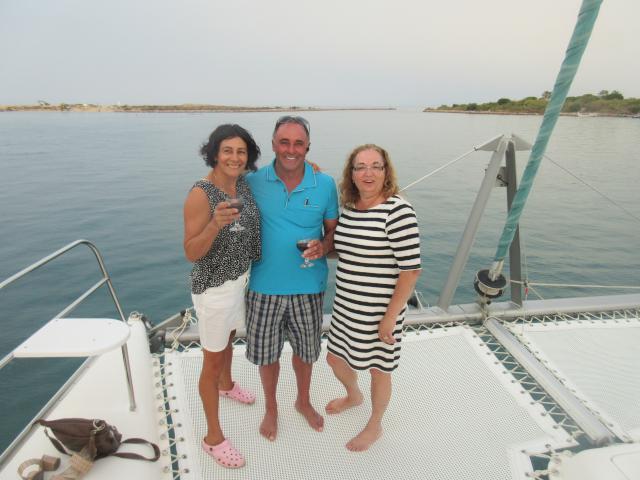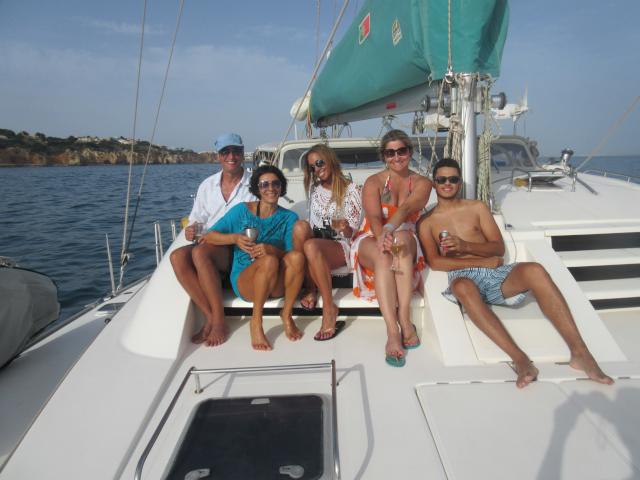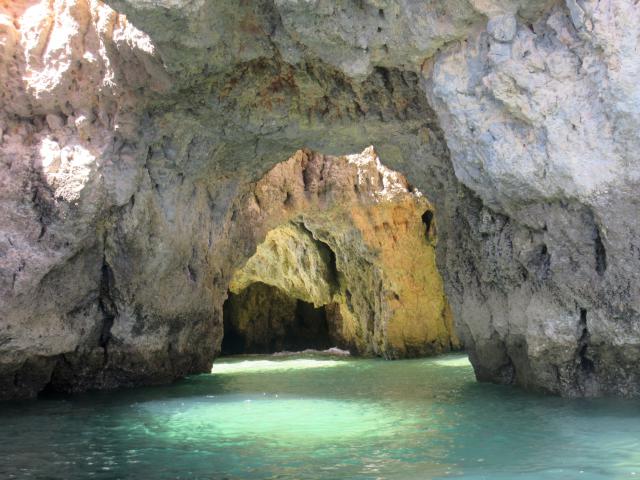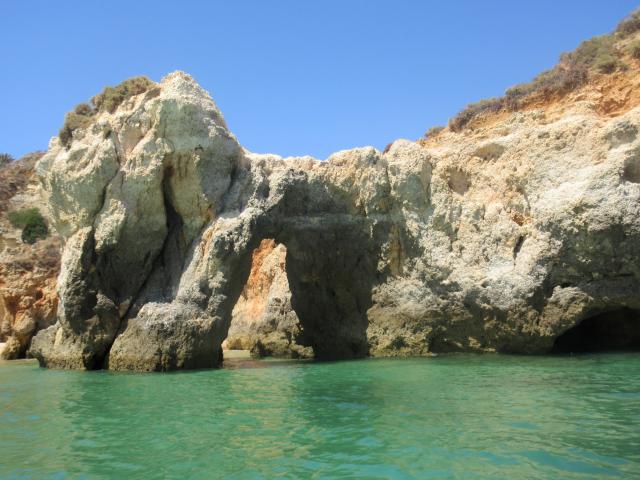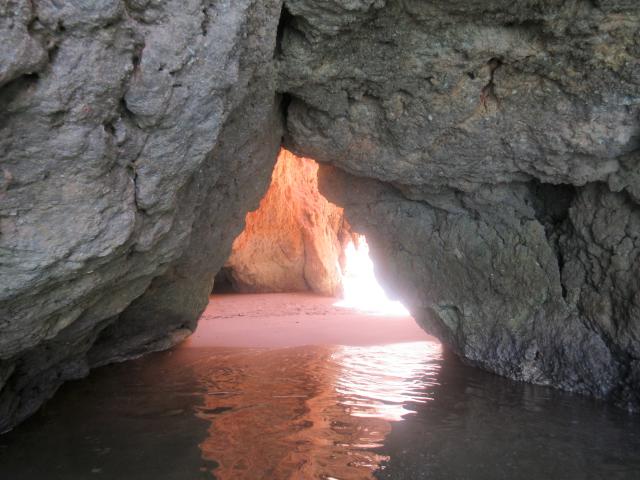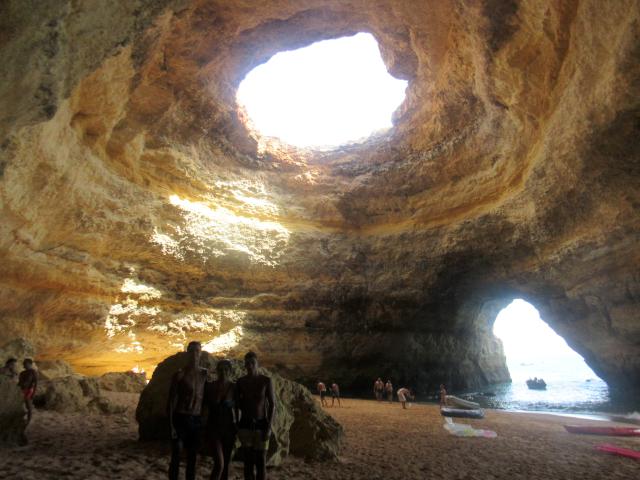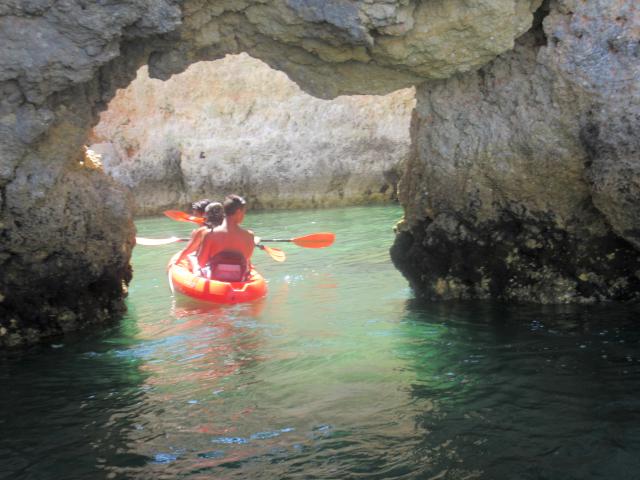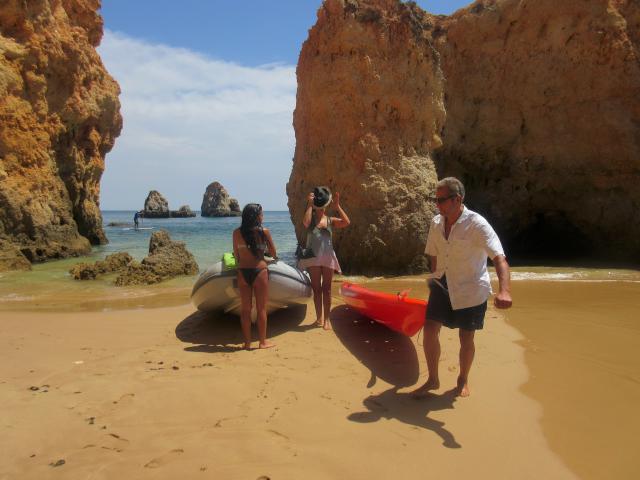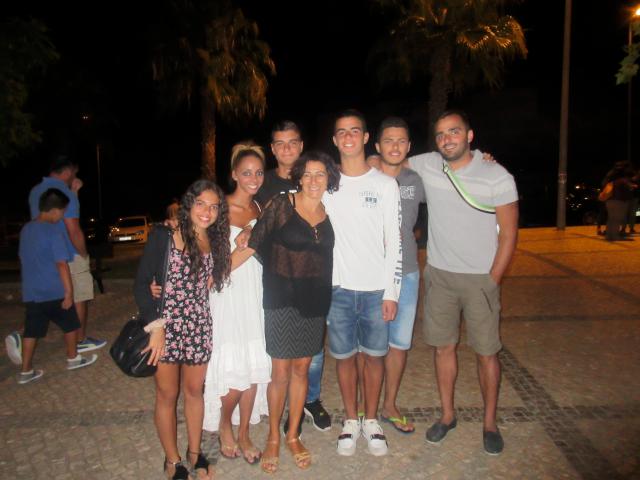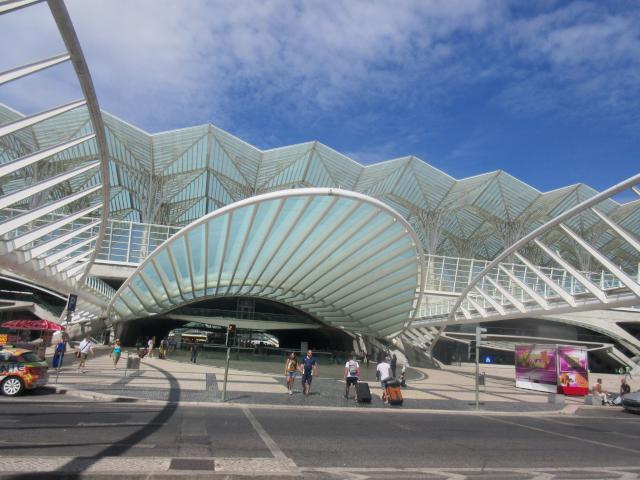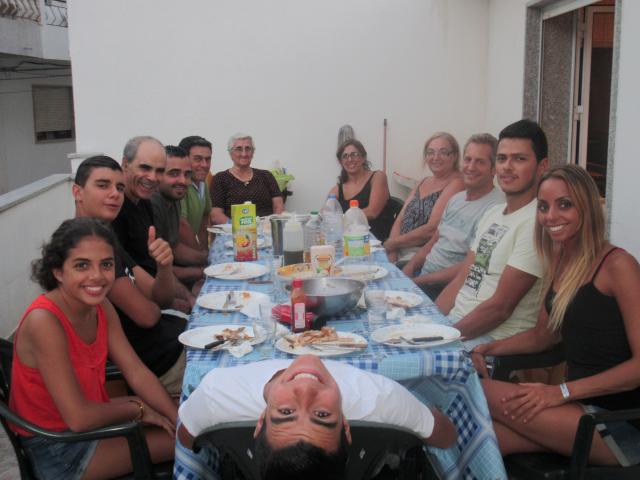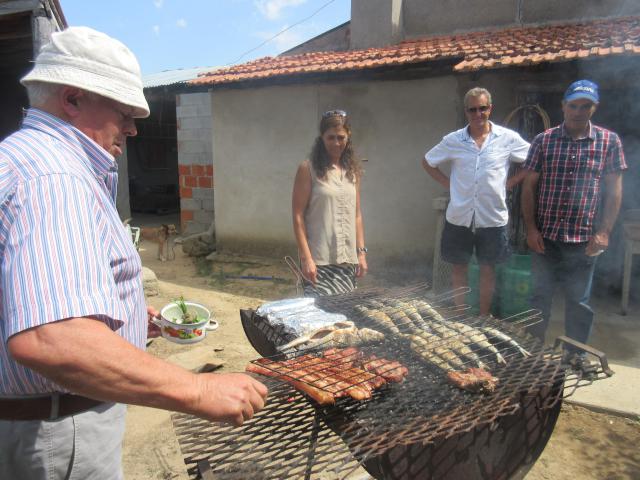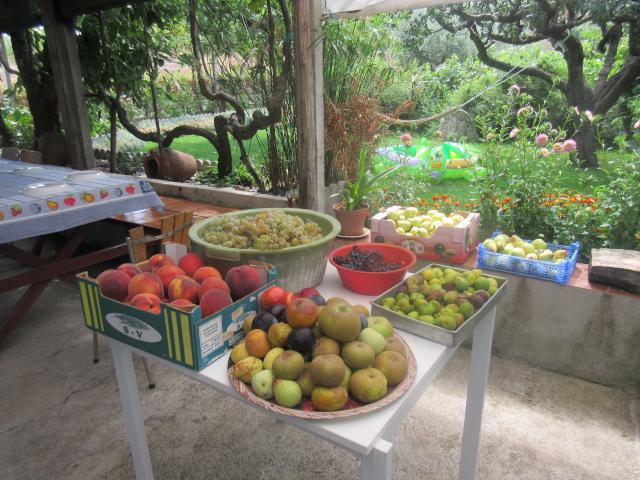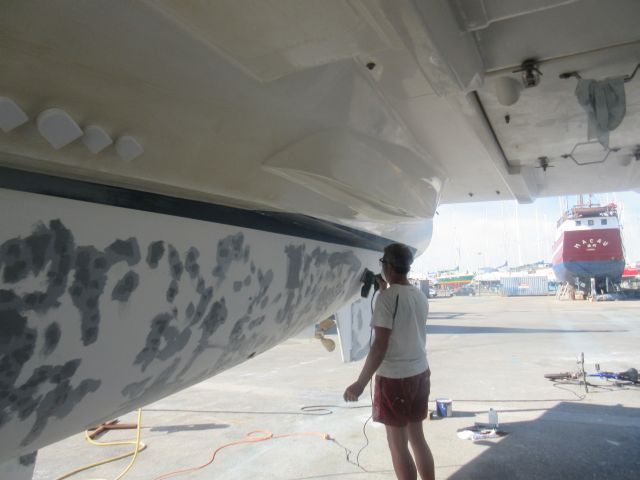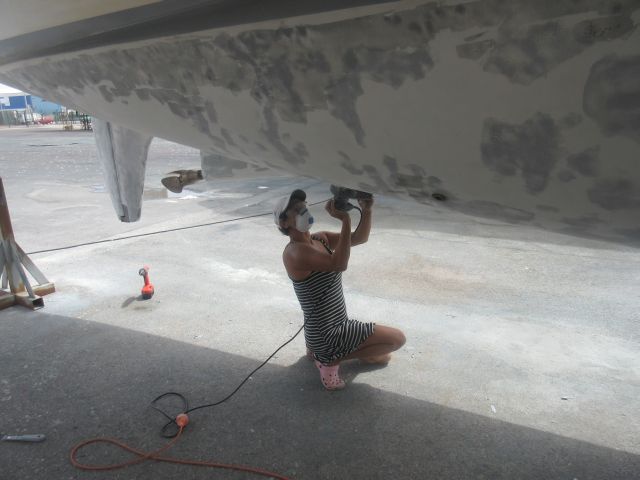Where to Anchor in Lisbon
Current Position: 38 41.83 N 009 24.98 W Click to view map.
Distance sailed since last post: 0 nautical miles. View the map of our voyage track here
Having spent a fair bit of time around Lisbon, I thought it would be useful to put up a summary of the area for other cruisers who want to visit.
Anchoring in Cascais
There are no useful anchorages near Lisboa itself. However, there is a good anchorage at Cascais, with protection from the prevailing N to W winds. It is open to the southern quadrants, but that is rarely a problem, at least through the summer months. Almost every evening the North wind will blow, sometimes quite strongly, but it usually then settles down overnight. In the summer it can be very calm in the mornings and through the day.
At Cascais you can tie up your dinghy at the fisherman’s pontoon, along the western seawall, close to the beach. The water in Cascais is almost always cold for swimming, and not very clear.
There is fuel and water easily available at Cascais Marina, but the marina itself is very expensive for mooring.
Cascais is a very pleasant town to visit. It is quite upmarket, with some good cafes and restaurants including, alledgedly, the ‘best ice cream in the world’. I am not sure the Italians would agree. But there was certainly a long line-up of people waiting to get in.
In Cascais there is a small Pingo Doce and a large Jumbo supermarket within walking distance through the center of the town, just across the other side of the railway station.
There is a bus terminus under Pingo Doce with buses that go up to Sintra, which is well worth a day trip for the historic palaces and gardens, one of which reminded me of Park Guell in Barcelona. There is a nice walk (or bus ride) along the waterfront to Boca do Inferno, a crag in the rock through which the water pounds when the waves are up. Cafe and ice cream available, as well as a public toilet, as this is a popular tourist stop. Beyond that is Cabo da Roca, the most westerly point of continental Europe.
From the train station there are frequent trains (every 15-20 minutes) along to coast towards Lisboa for a fare of about 1.4 Euros.
There are also sheltered anchorages (38 40.9N 009 18.6W) near to Oieras marina and just around the corner (38 41.7 N 009 14.4 W) from the Belem pilot boat harbour. Both of these suffer from having nowhere to dock your dinghy to go ashore, so are useful only as an overnight staging place. Note that the tide does run quite strongly through this bay.
Marina in Lisbon
The Marina Parque Das Nacoes is a new marina very close (1.8km) to the Orient train station, and the Oceanarium (which is well worth a visit). There is a nearby Continente supermarket (in the mall right next ot the train station) which will deliver directly to your boat. The marina is well sheltered, has good security, and are very friendly and helpful. There are no nearby bars making night-time noise, so it is very quiet. Water and Electricity are included in the very reasonably rates that they charge (eg 42 Euro per night, 600 euro per month in high season for a 12m catamaran including taxes) – much cheaper than most other places in Portugal. The airport is also very nearby, making this a good base for flying in and out of Lisboa. Try to arrive at the turn of the tide, as the tidal currents through the sluice gates can push you around quite a bit.
The water in the marina is VERY muddy, and the fouling is quite bad – even after just one month we had seaweed growing all over a piece of rope that we had allowed to dangle in the water. Our boat bottom, just cleaned, also had quite a bit of growth on it, as did the plastic bags with which we covered our props. When I dove in to retrieve the plastic bags the mud in the water was so thick I could not even see the propeller, and had to do it all by feel alone. Not so appealing. But better, in my mind, than a fouled propeller.
Anchoring and Mooring in Seixal
Across from Lisboa is Seixal. This is a small town, somewhat run down, but it does offer a very nicely sheltered anchorage. Access to Lisboa is by fast cheap ferry which runs regularly (depending on time of day) right from the town quay to downtown Lisboa (East side of the historic center). In Seixal there is a mini market that carries fruit, veg, meat and most of the staples that one needs. Taking the dinghy across to Amora you can then get a train to visit the Christo Rei monument, or to cross the bridge into Lisboa. Or you can take a bus or taxi to Fogueteiro train station. Note, however, that this train does NOT stop near the town center. For that you are best using the ferry. However, the train does go to Areeiros where you can change trains to go straight into Lisboa Oriente.
The ferry from Seixal takes 17 minutes and goes to Cais do Sodre, which is the end of the line that runs from Cascais. Times of the ferry are variable, be sure to check in advance so you don’t get caught out and have to wait two hours for the next one!
At low tides in Seixal you will see professional clam diggers at work. Using a tool that is a cross between a shovel and a rake they stand chest deep in the water and dig for clams which they sell to the restaurants. They will be happy to sell them directly to you for about 6.50 euro a kilo. Unfortunately the water in Seixal, indeed through the whole Tejo estuary is pretty muddy, so not very appetising for swimming, although all the locals do so. It is, however, quite a bit warmer than at Cascais. In September we saw hordes of jelly fish.
In Seixal there is a small dock where one can tie up one’s dinghy. On that dock is a small cabin. Ask in there to find out if there are any mooring balls availble. If there are, these offer very cheap boat storage (eg 90 euro a month in August for 12m boat, no extra for cats. Pro-rated for shorter stays). This would be a good option if you want to take time to explore elsewhere in the country, or need to take a quick trip back home.
Next to Seixal is Amora in which there is a haul-out boatyard which offers very reasonable rates – eg 180 euro for a month in August for a 37ft mono. I don’t know what size crane or lift they have.
Transport In Lisbon
Transport within Lisboa is plentiful, but a bit confusing. The trains from Cascais arrive into the western side of the historic downtown at Cais do Sodre. The trains from the rest of the country arrive on the eastern side, passing through the Oriente station and ending at Santa Apolonia. Between them there is a gap and there is no direct connection between the two system. Thus to get from Cascais to Oriente you have to cross the gap. This can be done by a 15 minute walk, for by bus, or by metro, but the metro requires you to change once!
Buses to the rest of the country mostly leave from the Sete Rios bus terminus, which is accessible by Metro or by Rail. But, to get to that from Cascais again requires a walk (eg from Alcantara Mar to Alcantar Terre), or bus or metro. Probably easiest is to go to Cais do Sodre and then figure out the buses or metro from there. Allow yourself plenty of time for the journey.
All modes of public transport around Lisbon use the same ticketing system. The first time you buy a ticket (usually from a machine) you will be charged an extra 50c and will receive a green Viva card. This card is rechargeable, so hold on to it. Next time you need a ticket, put the card into the machine and then load it up with either one or more tickets, or else an amount of money that you can then ‘Zap’ when you need a ride. Whenever you board a bus, train or ferry you will then validate your ticket at the entrance, which will debit your card either the ticket you bought, or the amount of money. Keep the receipt that shows you paid for the ticket until you have completed your journey. Public transport runs until about 1am.
Transport to the rest of Portugal from Lisboa is cheap and easy by both bus and train, both of which take about the same amount of time! Buying tickets online from http://cp.pt more than 5 days in advance can provide even more savings, but you will need a cell phone to which they can send a text message. I believe that without a cell phone you can also buy tickets by phone (eg from Skype) which you then pick up at the station. Some buses can be fully booked – so plan ahead. The site for bus times and tickets is http://rede-expressos.pt
Traveling by car is more expensive, as the fast roads have tolls, and the free roads end up being very slow.
Just Arrived in Lisbon
Current Position: 38 41.82 N 009 24.86 W Click to view map.
Distance sailed since last post: 102 nautical miles. View the map of our voyage track here
As forecast, the wind was light and from the south. This meant that we had to motor almmost the whole way from Cabo Sao Vincente, but that is better than having to beat into fresh northerlies, which is the normal Portuguese Trade Wind state of affairs.
So, without much fanfare, and with a few large Atlantic Mackerel, but no Tuna, caught, we arrived at Cascais at about 16:00 hrs and anchored behind the seawall off the beach, alongside about 5 other yachts.
On our way to Lisbon
It looks like we have some calm favourable winds over today and tomorrow, so we have decided that we are going to set off for Lisbon right now. If all goes to plan, we should be there around 3pm tomorrow afternoon.
Otherwise it will be a matter of waiting for another weather window, as the normal winds at this time of year are from the North, which makes sailing North somewhat of a challenge.
27 Fish and 36 Kite Surfers.
Current Position: 37 7.4 N 008 37.23 W Click to view map.
Distance sailed since last post: 4 nautical miles. View the map of our voyage track here
On Sunday we moved out of the marina to anchor in Portmao harbour. The next day we were minding our own business when we spotted a whole bunch of seagulls diving just 30 m from us. A fish feeding frenzy. Birds diving, fish leaping, we just had to go and join the fun.
So we jumped into the dinghy with a rod fitted with a one-inch spoon and went chasing fish. After the second fish, Ceu got the hook caught in her glove, so that cost us two fish while we went back to Life Part 2 to get her unhooked.
Out we went again and caught another two fish: total one mackerel, two spotted sea bass, and one herring.
The next day we set off in light airs towards Alvor, 4.5 miles away. As we ghosted along at about 1-5 to 2kts we trolled three lines behind us. One was the same trusty spoon. We also had two paravanes that dive down to about 5 meters as we pull them along. Attached to these we had two strings of feathers, one with 10 hooks and red feathers, the other with five hooks and purple feathers.
Just as I was setting up the paravanes, we had already caught one mackerel on the spoon. After that is was just a matter of pulling in one line, taking off the fish, putting the line back in the water, and pulling in the other line.
In less than an hour we decided we had better stop at 27 mackerel caught.
We anchored just inside the entrance to Alvor and dinghied into town for a quick look around.
Today we stayed. Why? Because though the mornings are calm, the afternoons get a fantastic force 5. The Alvor estuary is perfect for windsurfing and kitesurfing – it is almost totally enclosed, very shallow (you can stand in most of it) and has an unobstructed wind which, as I said, gets up to 20kts in the afternoon and evening.
So, naturally, I had to get the board out and go for a sail. Awesome. Though one does have to dodge the 36 kite surfers that were also out for a sail!
Then, this evening, two Leopard cats arrived. One from Vancouver and the other one also has a Canadian aboard!
It is all happening around here 🙂
Our Uganda Safari – Lions, Hippos and Giraffes
Current Position: 00 20.86 N 032 34.95 E Click to view map.
Here we are at the end of June, and we are only just back on board Life Part 2. So what on Earth have we been doing for the past 9 months?
After Dad’s death in September cut short our plans to cross the Atlantic last year, we hurriedly put Life Part 2 into Portimao Marina for 6 months. We had a month in England with Mum after the funeral, and then headed to Edmonton to see Ceu’s grandchildren and to check up on our rental property.
As it turns out, we ended up buying four more rental properties, including a nice apartment in Vernon, BC, where we stayed for 3 months while redecorating it and getting in 34 days of skiing at Silver Star. Ben also came over to join us for Christmas.
Having bought all these properties, we then had to renovate some of them! So that took up another hectic month in Edmonton. We also received news that Allisen in Edmonton was expecting her third son, due to arrive in August.
At this point it was clear that the 6 month contract at Portimao was not going to be enough, so we extended it to 9 months. We thought about extending it to a year, to take in August, but they wanted totally stupid money to do that, so we didn’t.
The 9 months, however, gave us time to spend a couple of weeks in England with Mum again, during which we did a canal boat trip along the Oxford Canal, which was delightful. Josh joined us for his birthday weekend.
After that, we took Mum to Portugal for a road trip during which she met with Ceu’s family in Casegas.
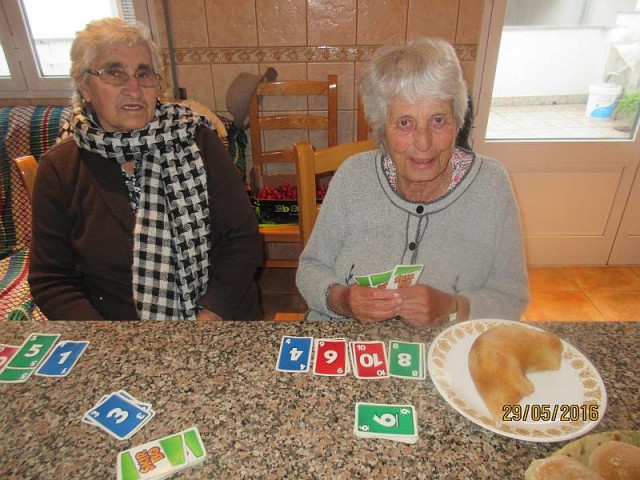
Ceu’s mom and my Mum enjoying a game of Skip Bo. The dish on the right is a classic Portuguese dish of stuffed pig’s stomach called borrelhão or arroz de bucho, a bit along the lines of a Scottish haggis.
That took us to the beginning of June, leaving us a few weeks still paid up at Portimao. What do do?
Well, with the boat secure in a marina, and with us still in Europe, this seemed like an excellent time to take in a trip to Uganda with my sister and her Ugandan husband. After all, who knows when we would next have such a convenient opportunity?
So, off we went – and what a blast we had!
David volunteered to do all the driving, so we took in a lap that included Lake Mburo and Queen Elizabeth National Parks as well as meeting up with his extensive family. The photos are below.
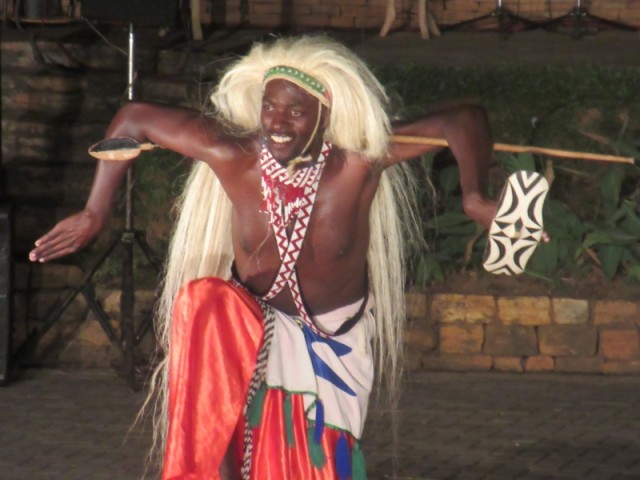
One of the traditional dancers at the Kempala Ndere Cultural Centre show. It was an excellent night out.
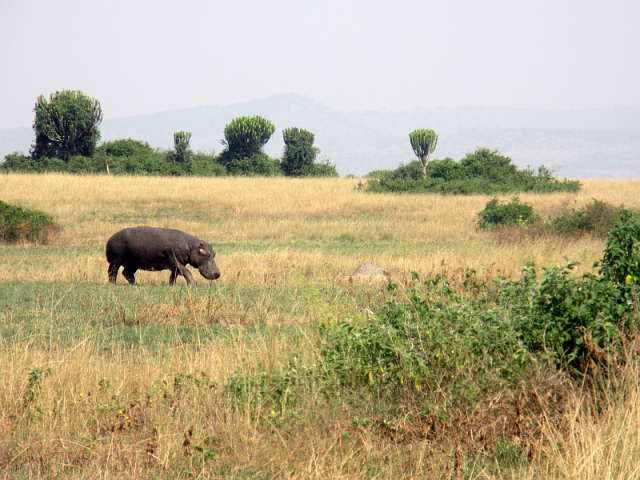
Hippo on a mission. We figure it had an injury which it did not want to get wet, otherwise it would be swimming in the lake rather than sweating in the midday sun. It was marching very purposefully across the savannah.

There were two pairs on lions very close together, but they then separated and found their own shelters
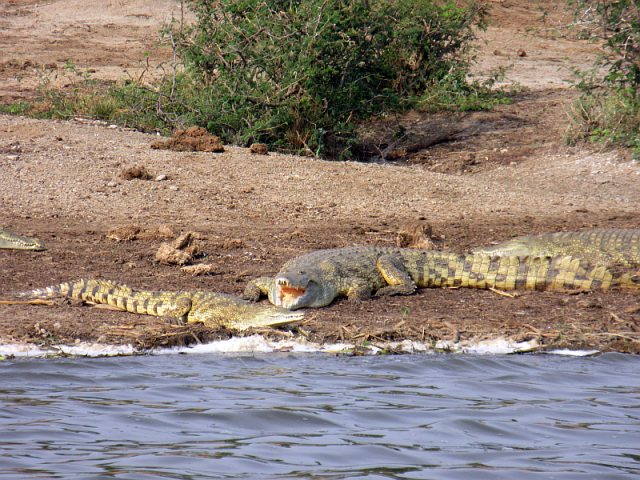
African crocodiles sunbathing, viewed from a boat trip along the Kazinga Channel in Queen Elizabeth NP
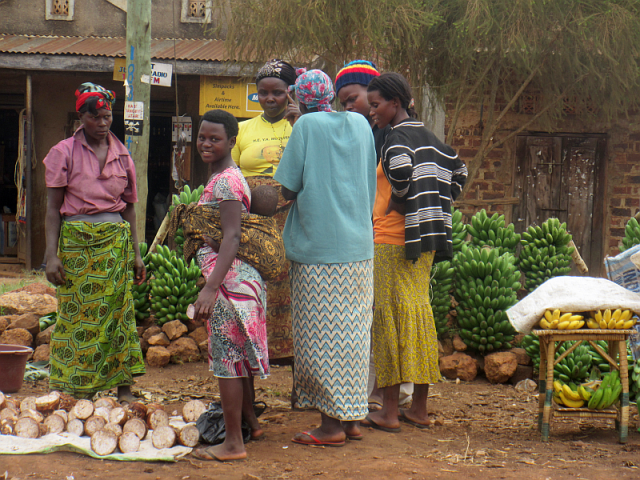
Matoke (plantain banana) is a staple food used rather like we use potatoes. On the ground are yams, which are also a starch crop.
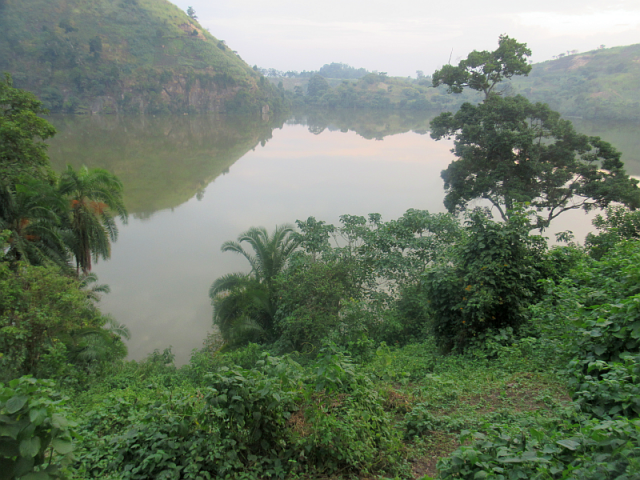
On of many crater lakes. Just north of Queen Elizabeth NP the land is pockmarked with numerous such craters, some with and some without lakes in them

Male weaver birds build multiple nests like these. If the female likes the construction, she lays eggs, if she doesn’t she rips it apart and drops it on the ground. Luck the bird who is a skilled weaver.
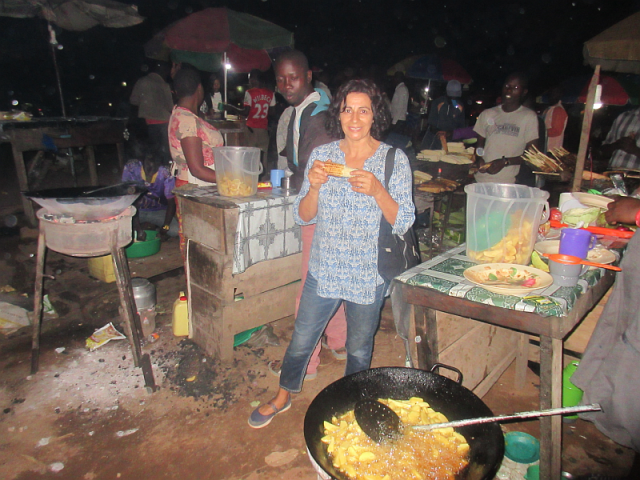
Fast food Ugandan style. Eating in restaurants, however, is far from fast, with meals often taking an hour or more to be prepared.
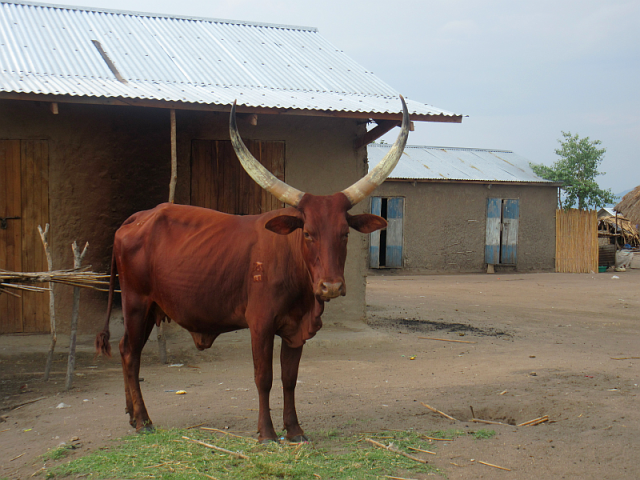
These cattle, with their enormous horns are everywhere. Fortunately they seem to be pretty good natured.
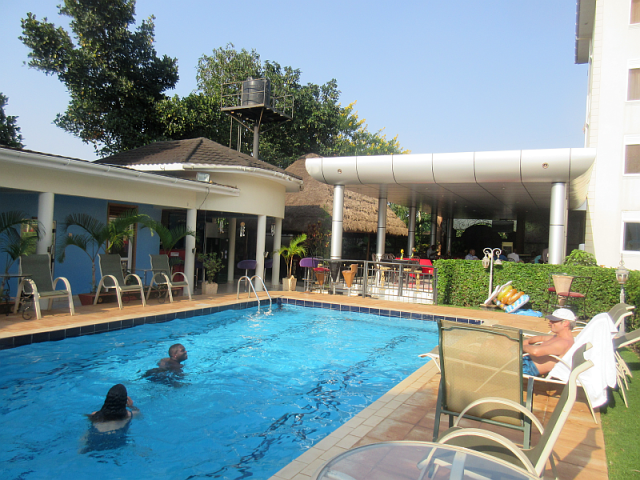
It’s not all poverty in Uganda. Here are Mitzi and David enjoying a swim in Kampala, with me on lifeguard duty,
And now we are back on board Life Part 2 for real.
First on the agenda is to do NOTHING! What with traveling between Vernon and Edmonton, then England, the canal boat trip, the Portuguese road trip, the travels in Uganda, we are tired of living out of suitcases. Time to settle in to our home and relax. Well, apart from all the cleaning that has to be done.
After that, we will potter around the Algarve for a few weeks and get some boat projects done: replacing the seals on some of the hatches, creating a water generator from our props (again) and installing a loud hailer / fog horn that we bought in Canada.
And then it is suitcase time again: the grandson due to be born in Edmonton is the siren call for Ceu to travel again. Ah, but where to leave the boat, since it is high season in Europe.
Two options present themselves:
1) See if we can find a cheap mooring in Morocco, in which case we can both travel, or
2) I stay on the boat, and Ceu goes alone for a couple of weeks.
The former option might be fun, and puts less time pressure on us, as the key timing event is the sail from Portugal to Madeira, which has to happen before the end of September. But if we are already in Morocco, that no longer presses upon us.
Well, we shall see, and will keep you informed.
Thanks for Your Messages
Thank you all for your kind comments and condolences on my Dad’s passing away.
We had a funeral service for him in Ottawa, attended by my Mum’s relatives and many long-standing friends of both.
The body was then cremated, and tonight we fly to the UK with the ashes. We will have another memorial celebration in Stubbington, Hampshire, UK and my mother will then scatter the ashes on the waves of the Solent – 62 years after they both arrived by ship at these same waters from Canada – the very same ship on which they first met.
My mother is holding up very well, but is obviously going to have some difficult adjustments to living alone for the first time in so long.
Ceu and I will return to British Columbia in a couple of weeks. We will stay there for the winter (and some skiing) and return to Life Part 2 in the spring.
Once again, thank you all for your kind wishes,
Noel & Ceu
BIG Change of Plans!
Well, we launched the boat today and were getting all ready to sail to Madeira.
But then I got a phone call that my Dad had died. He had been in hospital, but this was quite unexpected and sudden. I understand that yesterday he was laughing and joking, so if you have to go, this is the way to do it. He will be missed.
Fortunately we were not already at sea. So we have decided to park the boat here in Portimao marina and fly to Canada on Saturday to join my Mum in Ottawa. After that plans are undecided, but there is a good chance that we will just leave the boat here for 6 months and return in April to resume sailing. It delays our Atlantic crossing by a year, but plans are made to be changed.
Setting Sail for Madeira
Current Position: 37 8.2 N 008 31.7 W Click to view map.
Distance sailed since last post: 0 nautical miles. View the map of our voyage track here
All the work is done. This afternoon the big crane will put us back into the water. Then, on Friday (all things permitting) we will take off for Madeira.
The crossing is 470 nautical miles. The winds will be behind us, expecting 10 to 20 kts, and we will also have half a knot of current in our favour, so we expect to average at least 6kts. That would give us an expected arrival at Porto Santo sometime on Monday morning.
It is difficult on a longer passage like this, but we try to time our departure to give us the maximum chance of arriving during daylight as we don’t like to arrive at a strange new place in the dark.
While we are gone, we will have access to weather forecasts through our satellite phone, which we have just activated and set up. Through that we will also be able to post to our blog. In fact, this post was sent through the sat phone just to test that all is working well. Photos take up too much bandwidth, but at least we can tell you what we have been up to, and how many fish we have caught!
We may, or may not, post again prior to our departure, but unless you hear otherwise we will be out of communication from Friday to Monday. Having said that, I believe that we can receive SMS text messages through the phone, the number is +881631514902 and all you need to do to send us a text is go to: here, write in your message and send it. Free!
Bear in mind that we may not receive it straight away. In fact, we may not receive it for a few hours. Note that we can reply, but the reply will go to your email address, not to your cell phone. I just tested it, and it seems to work.
So, next contact should be from Mid Atlantic! Au revoir!
Applying CopperCoat: What a Job!
Finally it is done. But what a job!
The goal was to coat the bottom of Life Part 2 with CopperCoat. The reason? So we don’t have to keep finding boatyards to haulout the boat every couple of years.
So what is it? CopperCoat is an epoxy resin that is loaded with pure copper powder. Copper is toxic to marine life, and thus prevents the growth of flora and fauna on the bottom of the boat. It is the reason that the old square rigged ships of Nelson’s day had pure copper sheets nailed to their bottoms. In this it does the same job as any antifouling paint. But the difference is that normal anti-fouling wears off over the space of one to two years and then needs to be reapplied. And all that ‘wearing off’ goes straight into the ocean – not exactly the most environmentally friendly thing to do.
CopperCoat, on the other hand, is a hard epoxy resin that lasts at least a decade. In the boatyard we spoke to one worker who’s boat’s CopperCoat was still effective after 17 years. Over the years we have been ‘feeling bottoms’ whenever we came across a yacht with a CopperCoat bottom and, sure enough, it does seem to work. So we decided it was time to take the plunge and make it happen.
The original goal had been to haulout in Crotone, Italy, but when that didn’t work out and we ended up in Cariati, we had to go to plan B. While in Italy we ordered all the supplies we needed direct from CopperCoat and took them with us while we hunted around for the best place to do the job. And so we ended up here in Portimao where they speak English (most of the workers are actually Brits), which makes the whole process so much easier.
Putting it on is not a small undertaking. In fact, it is a Big Job. Here is what is involved:
- Remove ALL the old antifouling (that’s 15 years worth of buildup), right down to the original gelcoat.
- Prepare the gelcoat surface so that it is smooth and free of blemishes.
- Apply a barrier coat of epoxy primer that protects the boat from osmosis. Probably not strictly necessary, since there was no evidence of osmosis on our hull, but not a huge job since we are here.
- Apply 5 coats of CopperCoat ALL IN ONE DAY.
And, while we were at it, we would also redo our ‘go fast stripes’ since they were in bad shape, the workers in Tunisia having done a bad job of applying them then.
So here we go.
Stripping off the Old Antifouling.
How to remove the old antifouling? On the recommendation of CopperCoat themselves we decided to slurry blast the hull. Better would have been to find someone who did Soda blasting, but no one seems to do that. The slurry blasting was done by Bluewater Algarve, and took a couple of days.
This turned out to be a bad idea. The idea of low pressure slurry blasting is that it is supposed to not damage the gelcoat. In fact, it left our full badly pitted, whith therefore required a lot of remedial attention to make it good again. It also covered our boat with a lot of dirt which takes a lot of cleaning. We would have been better off to just scrape and sand the old paint off. A big job, true, but probably easier in the long run.
Preparing the hull
To get the hull into good shape again we got ourselves 4 litres of epoxy filler. With this we went over the whole hull filling in holes and skimming over the pitting left by the slurry blasting.
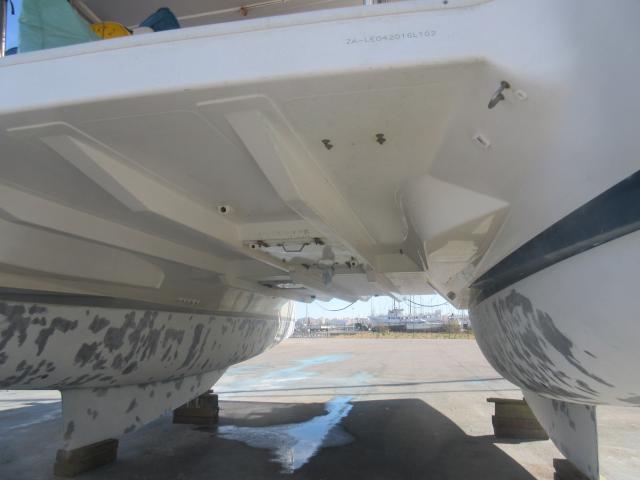
The grey blotches are where we filled in holes with epoxy filler. We also skimmed over the whole hull to flll in the rough pitting.
We then had to sand it all down. This took us three days.
Let me tell you, this is a LOT of work. Especially when the socket on the end of the extension cord did not seem to connect properly. In the end we just but the plug and socket off and wire the sander directly to the extension cord.
Applying the Barrier Coat
CopperCoat had supplied us with 5 litres of 3M Scotchkote epoxy primer. This is a very tough primer. Which is a good thing for protecting the boat. But a bad thing for sanding down. It is thick to apply – especially since we did not know we were supposed to thin it. We rolled it on, leaving an orange peel effect. The only thing is that CopperCoat supplied us with foam rollers – which dissolved in the epoxy paint, resulting in bits coming off onto the boat.
It looked nice. But it is very hard to sand down – much harder, in fact, than the epoxy filler.
Applying the CopperCoat
CopperCoat comes in three packs – the epoxy resin (water based), the hardener, and the copper powder. These all get mixed together, and then applied by roller. But it all has to be done in one day so that each coat melds chemically with the previous coat, resulting in one thick layer. According to the instructions, one normally mixes up one kit at a time – one pot of resin with one bottle of hardener and one bag of copper.
From our experience with the primer, we figured on about an hour to do one coat on one hull, so that should give us plenty of time to do it all in one day. We did one hull at a time. Having realised that the foam rollers fell apart, we bought some short-haired rollers which we hoped would be better.
We got up at first light and by 6:30am were at work sanding down the primer, which we had applied the evening before, ready for the CopperCoat. By about 10:30am we were ready for the real stuff.
The day was hot and sunny. The port side of the hull was in direct sun, making its surface temperature at least 40 deg C. The video of how to apply the CopperCoat makes it look very easy – just roll it one, and when you have done the hull it is time to just continue right around and do it again.
It turned out to be far from that.
We would load up the roller and apply it to the hull. Then we use the roller to spread it around and make it even. The problem was, the hull was so hot, that even as we spread it around, it was already drying. So while we were trying to spread it around, it would just pull off what we had just laid down. The result was a very patchy covering with thick areas, where we had applied the loaded roller, and bare areas where we had tried to spread it around. Also it was thickening in the pot while we were rolling it on.
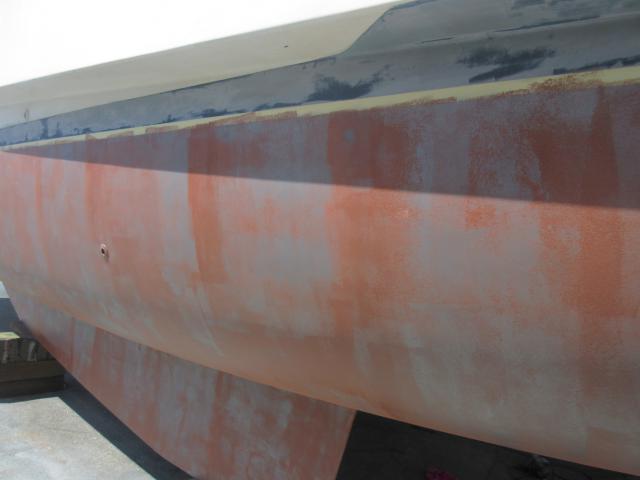
First coat, with many bare patches. Thin (30%) coverage is normal on the first coat, but some areas had almost none
We decided then to make up half a load instead of a full load each time, but even then it was getting thick before we were through with it.

Once mixed, the CopperCoat, according to Ceu, looked like chocolate mouse. But I think she was just getting delirious from working so long in the heat!
On the next lap it was even worse. Some ares would cover fine, but in others the already-drying layer that we were trying to spread around would pull off the previous layer, resulting in bare patches again.
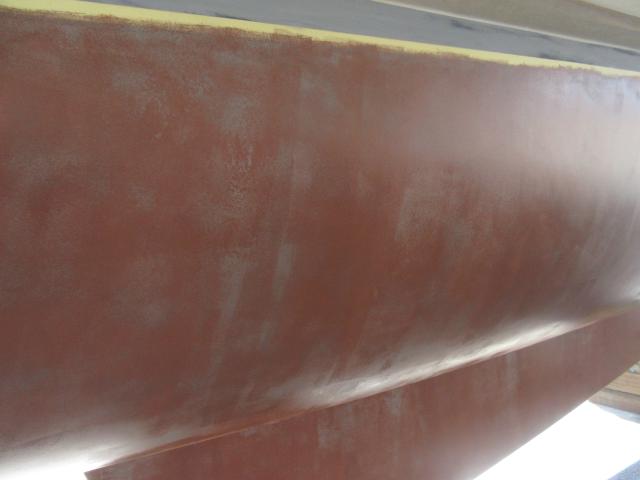
Second coat, but still some areas were just not getting covered. The other side of the hull, which was in the direct sun, was much, much worse.
We called CopperCoat who said to leave it a bit longer to harden before doing the next coat, and also to try using a thinner. So we tried that – and had the same problem.
By this time we were getting very frustrated with it, and were wondering how we were going to get it all covered properly.
At that point, Michel, who runs one of the boat-repair business in the yard had some advice for us:
1) wait even longer for the current coats to harden properly. So we stopped and had lunch.
2) use a 10cm (4 inch) roller instead of the longer rollers. This would double the time it took to do each coat, but did make it easier to control how much was going on with each roller load.
After lunch we went at it again. The previous layers were still quite tacky (impossible, according to CopperCoat, and puzzling according to Michel). But with the smaller rollers it was much easier to spread the load around quickly before it started to thicken on the hot hull.
With this technique we had greater success. Finally the CopperCoat was sticking and staying where it was put. But at 2 hours per coat it was 10pm before we were finally finished. We were applying the final coat in the dark with our headlamps.
But it was done.
The Second Hull
With our now vast experience, we wondered if the second hull would turn out better – or if we would now be so tired of working on it that it would be worse. I think, in the end, it was a bit of both.
It was the same process. Finish filling and sanding. Then the primer. Then the CopperCoat. This time we used small rollers and thinner. We started early. And we were done by 7pm. Another 12 hour work day.

Both hulls done. Keels still need doing, though. Once in the water the red of pure elemental copper will gradually change to the green of various copper compounds. This is a normal process and does not affect its effectiveness.
We went to the local Girasol restaurant for an excellent Prato do Dia – soup, enormous mixed grill, beer, and a huge piece of cake for 7.50 euros! And then a good sleep.
The next day it threatened to rain. The forecast never said anything about that! CopperCoat is water based, and at 20 deg it takes 4 days to fully cure. It is way warmer here so cures faster, but still we didn’t want water running all over it just yet! Arghh! What do we do? It’s weekend. There is no one around. We have no tarps or plastic. Frantically we rush around to find a solution:
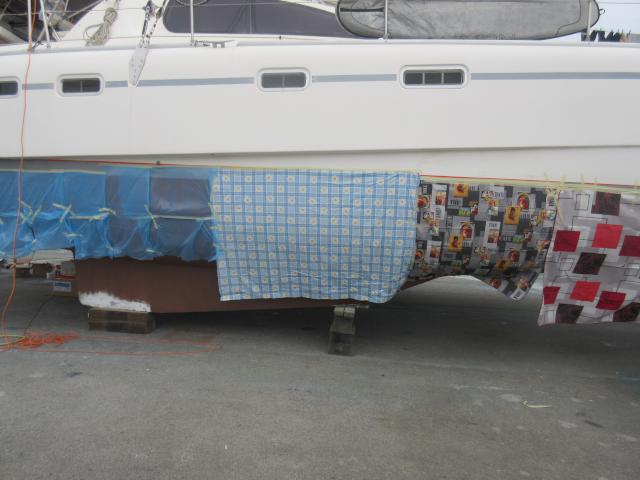
How to keep the rain off the new CopperCoat? How about using our waterproof tablecloths that we just bought?
Fortunately, it only spit at us a little, and no water got on the boat at all. Phew!
But no rest for the virtuous! There were still some more jobs to do: sanding, priming and sanding again for the ‘go fast stripes’, and getting the keel fixed and CopperCoated. To do that, we had to get the Travelift to re-position the supports so that the keel had full access.
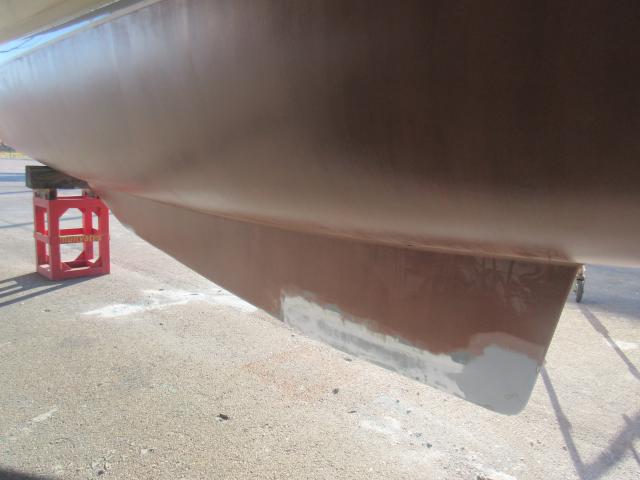
The starboard keel needed some repair (for the third time in the same place). Let’s hope it is done properly this time.
We also had Michel do the spray painting on the stripes so that they are super smooth.
And so, finally, Life Part 2 is ready for the water and, we hope, won’t have to be pulled out again for many years!
What a Difference an Ocean Makes
Current Position: 37 8.2 N 008 31.7 W Click to view map.
Distance sailed since last post: 126 nautical miles. View the map of our voyage track here
For three months we caught nothing. That’s nothing with a big fat ZERO, despite trying every combination of lures and speed in all sorts of weather. We tried a bird teaser. We tried squid daisy chains. We had diving plugs and spoons. We had up to four lines out. And we caught nothing.
Then we turn the corner from the Med into the Atlantic, and suddenly we are catching multiple fish every day!
First we catch two delicious tuna as we sail up from Gibraltar to anchor first outside Puerto de Conil 36 17.7 N 006 08.0 W and then at Bonanza, just inside the mouth of the Guadalquivir river that leads to Seville.
From there we sailed more slowly, this time trailing some mackerel feathers and spoons. And, sure enough, we started to catch mackerel, sometimes two at a time.
From Bonanza a long sail took us to Tavira, in Portugal, where we anchored just inside the river. Here we met up with Virgilio and Lurdes (Ceu’s brother and sister-in-law). We brought them onboard, along with Nancy, Uncle Tony, and Aunt Connie, for their first visit to Life Part 2.
We then moved five miles east to anchor off Manta Rota to visit with Virgilio for a big dinner at his home.
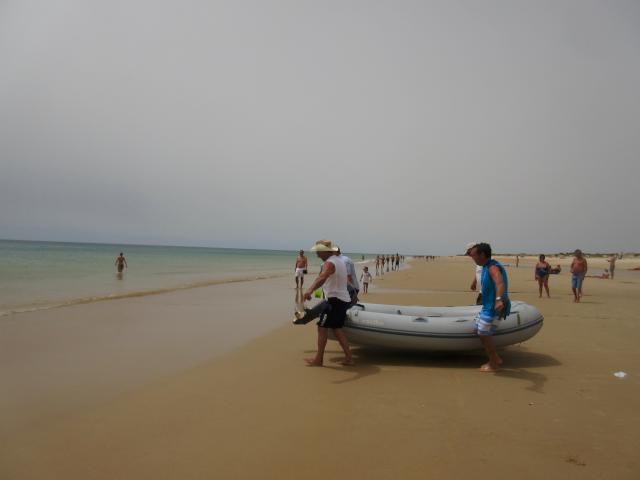
Bringing the dinghy up above the high tide line at Manta Rota, with the help of Uncle Tony and Virgilio and his friend
He also took us for a drive up to rio Guadiana where we noticed a few boats being at anchor right in front this beautiful town of Vila Real. We spent a peaceful night at anchor just off the beach of Manta Rota and in the morning we dashed off westward to get to Albufeira enjoying the beautiful coastline.
There we picked up Nancy and Rafael(niece and nephew)and cousins Daniel and Juliana and took them for a sunset cruise to some caves at Praia de Benagil (37 05.0 N 008 24.7 W).
On the way I decided to put out the mackerel feathers again and within 2 minutes had a bite.
The caves along here are truly dramatic and, in the evening, so beautiful with no crowds there! Definitely worth a visit.
After returning the youngsters to Albufeira so they could party, we anchored outside the harbour and, in the morning, set off for Portimao.
In Portimao we were boarded by yet more relatives, whom we took for a gentle cruise to see more dramatic caves both east and west of Portimao.

Sister and family arriving wit all kinds of fresh fruits and vegetables form their gardens, even my mom’s delicious olive oil. What a treat!
Well, it would have been gentle, except for one thing: outside the caves of Carvoeiro the anchor holding is rather better than one wants. A quick snorkel dive revealed that the anchor chain was well wrapped around and under several big rocks. What was supposed to be a very brief stopped turned out to take a bit longer.
Unfortunately, the waves had picked up a bit, so our landlubbers on boards were not feeling to great while I got out the HookahMax diving gear and went down seven meters to untangle things. Of course at the bottom of the sea one cannot feel the waves at all, so it was actually a small matter to get us free.
Once again self-reliance wins the day. Without our own gear we would have had to call in a diver. To do that, we would probably have had to take the passengers ashore and put them in a hotel while we got things sorted out. Instead we were on our way in about an hour.
For this trip westward we had Elisa and Carlos, daughter Sara plus Nicola and Adrien (Lucia’s sons). We continue to catch more mackerel, which delighted Nicola. He decided to become our head fisherman and proved his worth by even cleaning the fish – despite the fact that he won’t eat any of them!
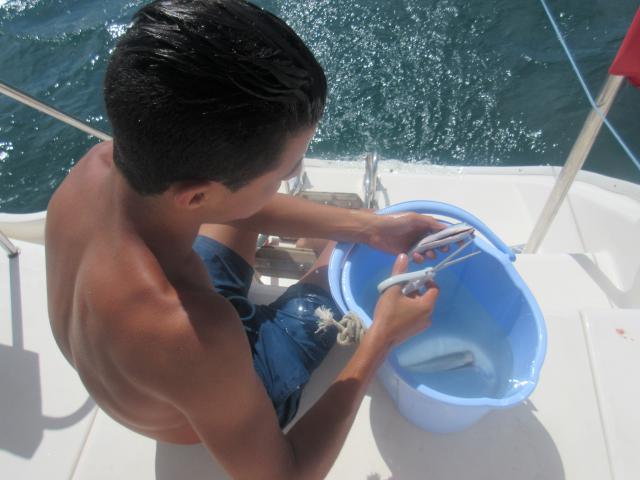
he asked me how to clean the fish. I told him what to do, now we just need to get him on board more often…..we had so much fun!
Nice sunset cruising back to Portimao where we had fresh fish on the Bbque and a nice stroll into town in the evening. Met up with more family and friends that were in holidays there.
Next day we had another sister, Lucia and her boyfriend visiting for the day. Visited more of the coastline and found paradise! a few deserted beaches! What a treat, just around the corner from crowded popular praia da rocha.
Once all the visitors had left, we hauled out Life Part 2 at Bluewater Algarve. We are having the bottom slurry blasted to remove all the old anti-fouling, right back to gel coat. We will then apply two coats of barrier epoxy, followed by four coats of Coppercoat. This is an epoxy resin that is filled to 80% capacity with real copper powder. We will have almost as much copper on the bottom of Life Part 2 as Nelson had on HMS Victory. The hope is that this will avoid the need for any more antifouling haulouts for another 10 years. Let’s hope it lives up to the hype!
While that was happening, we went inland to visit with Ceu’s mother, and the numerous other relatives that live there. Plus other siblings that were visiting from Canada.
On the way back from there we stopped off at Lisbon to pick up visas for visiting The Gambia.
And now its work time in Lifepart2. Ceu says: “Not sure I’d signed up for that! haha”

